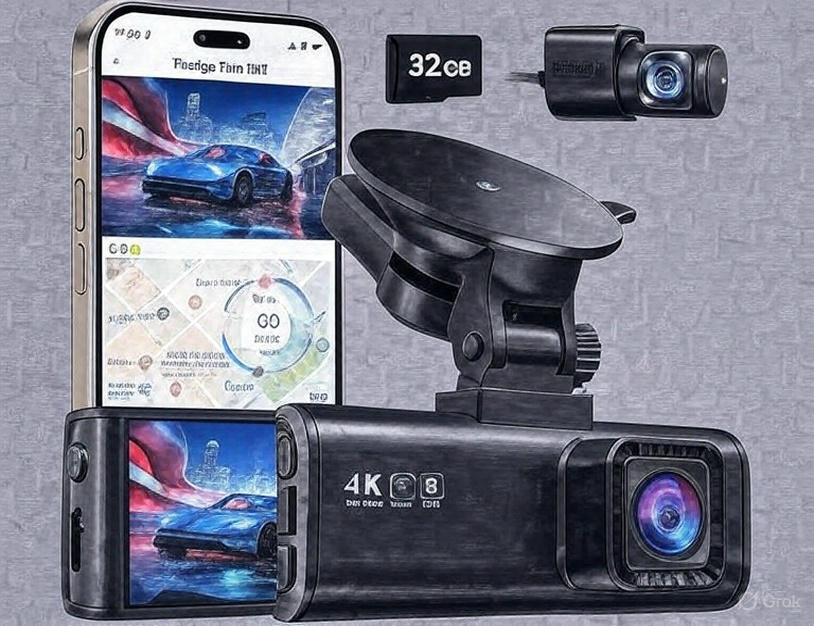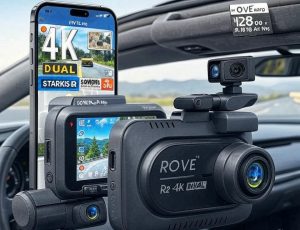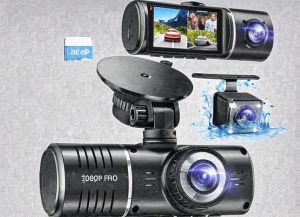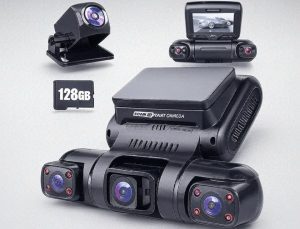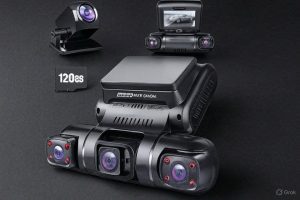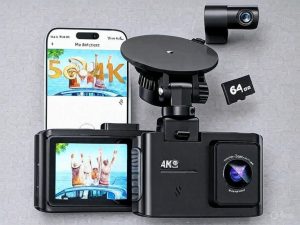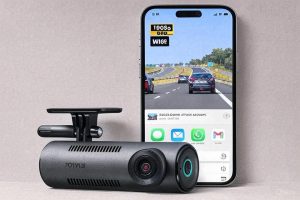Finding the perfect dash cam without breaking the bank has become a priority for many drivers in 2025. With increasing concerns about road safety, insurance fraud, and protecting your vehicle, a reliable dashboard camera serves as your silent witness on the road. The good news? You don’t need to spend hundreds of dollars to get excellent video quality and essential features.
After extensive research and analysis of current market trends, we’ve compiled this comprehensive guide to help you choose the best dash cam under $100. These budget-friendly options deliver impressive 4K video quality, dual-channel recording, and smart features that were once reserved for premium models.
Contents
- Why You Need a Dash Cam in 2025
- Key Features to Look for in Budget Dash Cams
- Top 5 Best Dash Cams Under $100: Detailed Reviews
- Installation and Setup Guide
- Maintenance and Troubleshooting Tips
- Legal Considerations and Privacy
- Comparison with Higher-End Models
- Future Trends in Dash Cam Technology
- Making Your Final Decision
- Conclusion
Why You Need a Dash Cam in 2025
Modern driving presents unique challenges that make dash cams more valuable than ever. Traffic congestion continues to increase in urban areas, while road rage incidents and insurance scams have become more sophisticated. Having video evidence can protect you financially and legally when accidents occur.
Insurance companies increasingly recognize dash cam footage as valid evidence, often expediting claims processing when clear video documentation exists. Some insurers even offer discounts for drivers who install dashboard cameras, recognizing their role in promoting safer driving habits.
Beyond accident protection, dash cams capture memorable road trips, unusual wildlife encounters, and scenic drives that you’ll want to share with friends and family. The peace of mind alone makes the investment worthwhile for most drivers.
Key Features to Look for in Budget Dash Cams
Video resolution stands as the most critical factor when selecting a dashboard camera. While 1080p remains acceptable for basic recording, 4K resolution provides superior detail that can make the difference in reading license plates or identifying road signs in footage. The extra clarity becomes especially important during insurance claims or legal proceedings.
Night vision capabilities separate average dash cams from exceptional ones. Advanced sensors like STARVIS technology enhance low-light performance, ensuring clear footage during dawn, dusk, and nighttime driving. This feature proves invaluable since many accidents occur during reduced visibility conditions.
Dual-channel recording offers comprehensive coverage by capturing both front and rear views simultaneously. This setup protects against rear-end collisions and provides complete situational awareness. Single-camera systems leave significant blind spots that could prove costly during incidents.
Storage and loop recording functionality ensures continuous operation without manual intervention. Quality dash cams automatically overwrite oldest footage when memory cards reach capacity, maintaining seamless recording. Look for models that support high-capacity microSD cards for extended recording time.
WiFi connectivity and mobile app integration have become standard features that enhance user experience significantly. These capabilities allow wireless footage transfer to smartphones, remote camera control, and real-time viewing without removing memory cards.
GPS tracking adds valuable context to recorded footage by embedding location data and speed information. This metadata can prove crucial during insurance claims or legal proceedings, providing undeniable evidence of your vehicle’s position and velocity.
Top 5 Best Dash Cams Under $100: Detailed Reviews
1. REDTIGER F7NP 4K Dash Cam Front Rear – Editor’s Choice
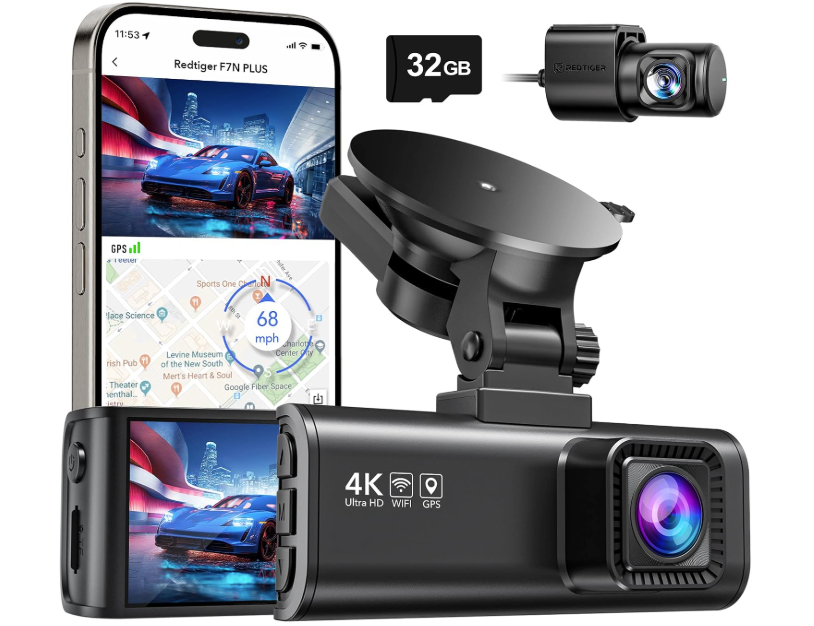
The REDTIGER F7NP stands out as our top recommendation for budget-conscious drivers seeking premium features. This dual-channel system delivers exceptional 4K front recording paired with 2.5K rear capture, providing crystal-clear footage that captures fine details like license plates and road signs with remarkable clarity.
The 3.18-inch IPS display offers excellent viewing angles and vibrant colors, making it easy to review footage directly on the device. Built-in WiFi enables seamless smartphone connectivity through the dedicated mobile app, allowing wireless file transfer and remote camera control without the hassle of removing memory cards.
GPS functionality automatically embeds location data and speed information into recordings, creating comprehensive evidence that insurance companies and legal professionals readily accept. The included 32GB microSD card provides immediate recording capability, though users can upgrade to larger capacity cards for extended storage.
Night vision performance impresses with clear footage during low-light conditions, thanks to advanced image processing and wide dynamic range (WDR) technology. The 170-degree wide-angle lens minimizes blind spots while maintaining image quality across the entire field of view.
Parking mode surveillance activates automatically when the vehicle is parked, monitoring for potential impacts or suspicious activity. This feature requires hardwire installation for 24-hour operation but provides invaluable protection in parking lots and driveways.
The G-sensor detects sudden acceleration, braking, or impact, automatically protecting critical footage from deletion during loop recording. This emergency lock function ensures important incidents remain preserved for later review.
Pros:
- Excellent 4K/2.5K dual recording quality
- Large 3.18″ IPS screen with intuitive interface
- Built-in WiFi and GPS functionality
- Comprehensive parking mode surveillance
- Included memory card for immediate use
Cons:
- Requires hardwire kit for full parking mode functionality
- Slightly larger form factor than some competitors
2. ROVE R2-4K DUAL Dash Cam with STARVIS 2 Sensor
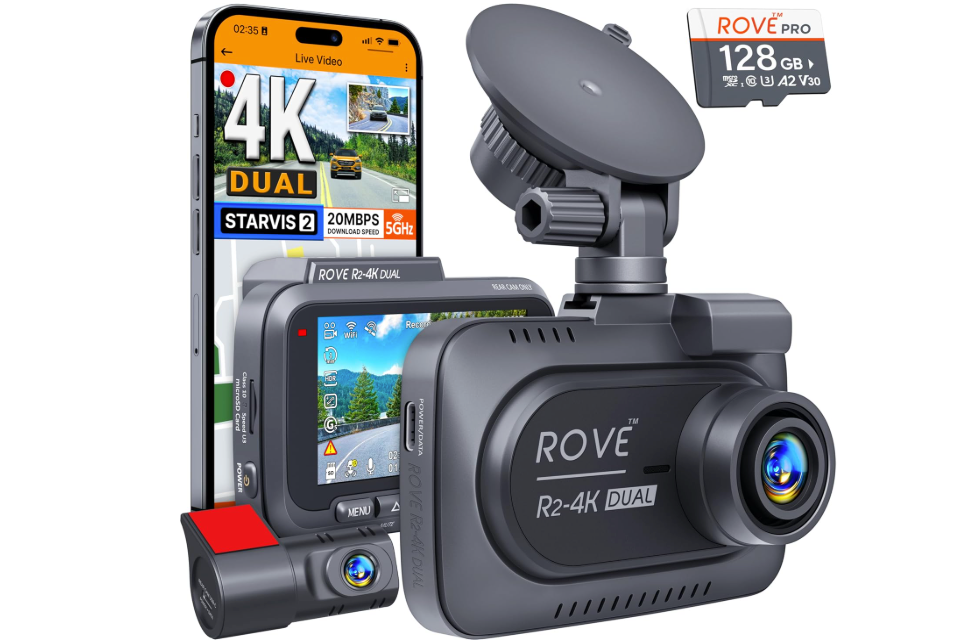
The ROVE R2-4K DUAL elevates dash cam technology with its advanced STARVIS 2 sensor, delivering exceptional low-light performance that outshines many competitors. This cutting-edge sensor technology ensures clear footage during challenging lighting conditions, from dawn and dusk driving to nighttime urban environments.
True 4K front recording combined with full HD rear capture provides comprehensive coverage without compromising image quality. The dual-channel setup captures every angle, protecting against both front-end collisions and rear-end impacts that increasingly target luxury vehicles in urban areas.
Premium 5G WiFi connectivity offers lightning-fast file transfers up to 20MB/s, significantly reducing the time needed to download footage to smartphones or tablets. This enhanced speed makes sharing incident footage with insurance companies or law enforcement much more efficient.
The included 128GB memory card provides exceptional value, offering weeks of continuous recording before loop recording begins overwriting older files. This generous storage capacity reduces concerns about losing important footage during extended trips or busy driving periods.
Parking mode surveillance operates for up to 24 hours when properly hardwired, monitoring for impacts, motion, or attempted break-ins. The intelligent system conserves power while maintaining vigilant protection, ensuring your vehicle remains monitored even in remote parking locations.
Voice control functionality allows hands-free operation, enabling drivers to capture specific incidents or adjust settings without taking their hands off the steering wheel. This safety-focused feature promotes responsible driving while maintaining full camera control.
Pros:
- Superior STARVIS 2 sensor for exceptional night vision
- Ultra-fast 5G WiFi with 20MB/s transfer speeds
- Generous 128GB memory card included
- Advanced parking mode with extended battery life
- Voice control for hands-free operation
Cons:
- Higher price point within the under-$100 category
- Complex menu system may overwhelm novice users
3. Generic 4K Dual Channel Dash Cam with 5GHz WiFi
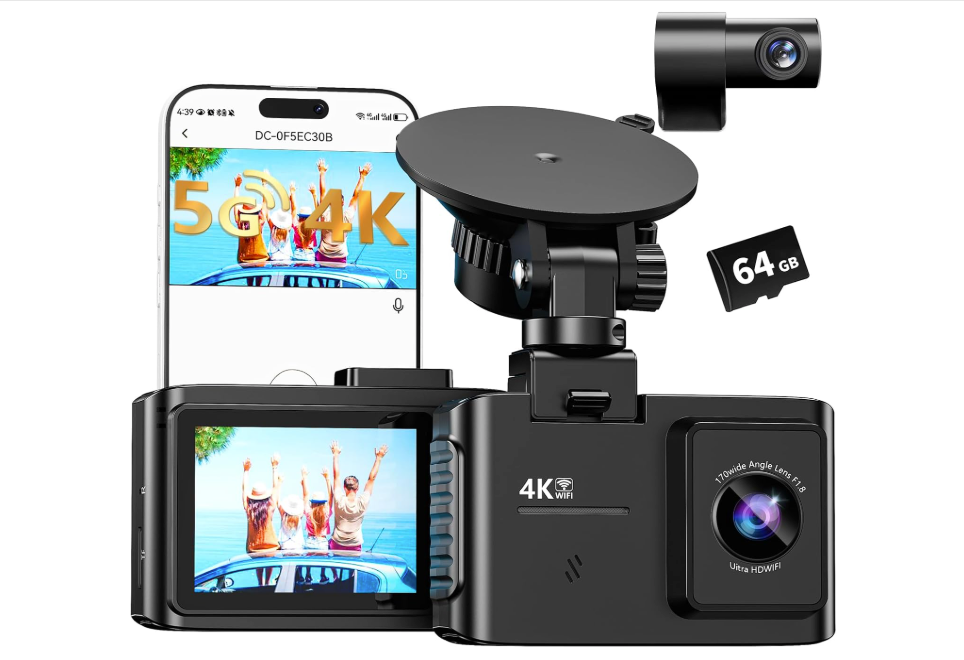
This versatile dual-channel system proves that exceptional features don’t require premium branding. The 4K front camera paired with 1080p rear recording delivers professional-quality footage that rivals more expensive alternatives, making it an excellent choice for budget-conscious buyers.
5GHz WiFi connectivity provides stable, high-speed connections that maintain reliability even in congested wireless environments. The improved frequency reduces interference from other devices, ensuring consistent app performance and faster file transfers.
The compact 2.0-inch IPS screen strikes an ideal balance between functionality and discretion, providing clear playback without overwhelming the dashboard or obstructing the driver’s view. The intuitive interface makes navigation simple, even for users unfamiliar with dash cam technology.
The included 64GB memory card offers substantial storage capacity, typically providing 8-10 hours of dual-channel recording before loop recording begins. This generous allocation ensures important footage remains available for review and download.
G-sensor protection automatically detects impacts, sudden acceleration, or hard braking, immediately locking the current recording segment to prevent deletion. This emergency protection ensures critical evidence remains preserved during the chaos following an accident.
Loop recording operates seamlessly in the background, continuously capturing footage while automatically managing storage space. The intelligent system prioritizes protected files while maintaining smooth operation throughout extended driving sessions.
Wide-angle 170-degree lenses capture expansive views that minimize blind spots and provide comprehensive coverage of traffic situations. The broad perspective proves especially valuable at intersections and during lane changes.
Pros:
- Excellent 4K/1080p dual recording quality
- Reliable 5GHz WiFi connectivity
- Compact design with clear 2″ screen
- Substantial 64GB memory card included
- Comprehensive protection features
Cons:
- Generic branding may concern some buyers
- Limited customer support compared to established brands
4. REDTIGER F7N Touch 4K with STARVIS 2 Sensor

The REDTIGER F7N Touch represents the evolution of dashboard camera technology, combining premium STARVIS 2 sensor technology with intuitive touch screen operation. This advanced system delivers professional-grade video quality that captures fine details with exceptional clarity, even in challenging lighting conditions.
The 3.18-inch touch screen interface revolutionizes dash cam operation, providing smartphone-like navigation that feels familiar and responsive. Users can easily adjust settings, review footage, and access advanced features through simple touch gestures that eliminate the confusion often associated with traditional button controls.
STARVIS 2 sensor technology ensures superior night vision performance that captures clear footage during the darkest conditions. This advanced imaging sensor significantly outperforms standard cameras, providing usable footage when other systems produce grainy, unclear recordings.
Voice control integration allows complete hands-free operation, enabling drivers to activate recording, capture photos, or adjust settings without removing their hands from the steering wheel. This safety-focused approach promotes responsible driving while maintaining full camera functionality.
The generous 128GB memory card provides extensive storage capacity that supports weeks of continuous dual-channel recording. This substantial allocation reduces concerns about storage management while ensuring important footage remains available for extended periods.
5.8GHz WiFi connectivity offers premium wireless performance with reduced interference and faster transfer speeds. The advanced frequency provides more stable connections in crowded wireless environments, ensuring reliable app communication and efficient file downloads.
GPS integration automatically records location data, speed information, and time stamps, creating comprehensive documentation that proves invaluable during insurance claims or legal proceedings. This metadata provides undeniable evidence of your vehicle’s position and circumstances during incidents.
Pros:
- Premium STARVIS 2 sensor technology
- Intuitive touch screen interface
- Voice control for hands-free operation
- Massive 128GB memory card included
- Advanced 5.8GHz WiFi connectivity
Cons:
- Premium features push pricing toward upper budget limit
- Touch screen may attract fingerprints and smudges
5. Budget 4K+1080P Dual Dash Cam with Free 64GB Card
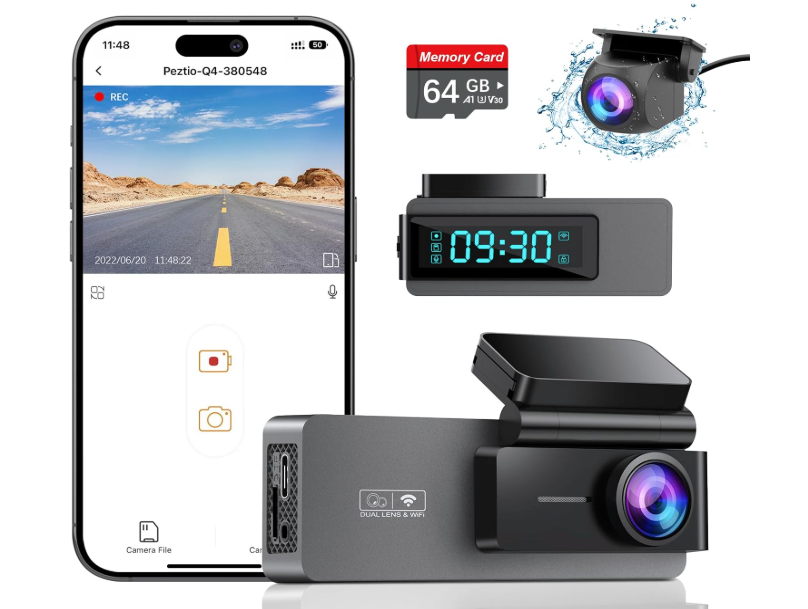
This value-focused dual-channel system proves that essential dash cam features remain accessible at entry-level prices. The 4K front camera captures sharp, detailed footage that clearly shows license plates, road signs, and traffic situations, while the 1080p rear camera provides adequate coverage for most driving scenarios.
Built-in WiFi connectivity enables wireless footage transfer and remote camera control through smartphone apps, eliminating the need to remove memory cards for file access. This convenience feature significantly improves user experience while maintaining the simplicity that appeals to first-time dash cam buyers.
24-hour parking monitor surveillance provides continuous protection when properly hardwired, detecting impacts, motion, or attempted break-ins around your parked vehicle. This security feature proves especially valuable in urban environments where vehicle vandalism and theft attempts remain common concerns.
The included 64GB memory card delivers immediate recording capability with sufficient capacity for typical driving patterns. Most users find this storage allocation provides adequate coverage for daily commuting and weekend trips without requiring frequent file management.
Night vision capabilities ensure acceptable footage quality during low-light conditions, though performance doesn’t match premium STARVIS sensor systems. The camera produces usable recordings during dusk and dawn driving, providing valuable evidence when accidents occur during reduced visibility periods.
Loop recording operates automatically in the background, continuously capturing footage while managing storage space efficiently. The system prioritizes emergency-locked files while maintaining smooth operation that requires minimal user intervention.
Dual camera installation provides front and rear coverage that protects against both collision types that commonly affect drivers. This comprehensive approach ensures important incidents receive proper documentation regardless of impact direction.
Pros:
- Excellent value for dual 4K/1080p recording
- Built-in WiFi for convenient connectivity
- 24-hour parking surveillance capability
- Free 64GB memory card included
- Simple operation ideal for beginners
Cons:
- Basic night vision compared to premium models
- Limited advanced features and customization options
Installation and Setup Guide
Installing your new dash cam properly ensures optimal performance and longevity. Most budget dash cams use similar mounting systems that attach to the windshield using adhesive mounts or suction cups. Choose a location behind the rearview mirror that doesn’t obstruct your view while providing clear sight lines through the windshield.
Route power cables along the headliner and down the A-pillar to maintain a clean, professional appearance. Avoid running cables across airbag deployment zones, and ensure connections remain secure during normal driving conditions. Many users find cable management challenging initially, but taking time for proper routing prevents future problems.
Rear camera installation requires running cables from the front unit to the back window, typically through interior panels or along floor trim. This process demands patience and basic tools, but most drivers can complete installation within 2-3 hours using online tutorials and included instructions.
Memory card formatting ensures compatibility and optimal performance with your chosen dash cam. Use the camera’s built-in formatting function rather than computer-based tools, as this process optimizes the card for continuous recording applications. High-endurance memory cards specifically designed for dash cams provide better reliability than standard cards.
WiFi setup connects your dash cam to smartphone apps for remote control and file transfer. Follow manufacturer instructions carefully, as connection procedures vary between brands. Once configured, wireless connectivity eliminates the need to remove memory cards for footage access.
GPS calibration ensures accurate location and speed data recording. Allow the system several minutes to acquire satellite signals during initial setup, and verify accuracy using known locations. Proper GPS configuration provides valuable evidence that supports insurance claims and legal proceedings.
Maintenance and Troubleshooting Tips
Regular maintenance extends dash cam life and ensures reliable operation when you need it most. Clean the lens monthly using microfiber cloths and appropriate cleaning solutions, avoiding household cleaners that can damage anti-reflective coatings. Dust and debris accumulation significantly reduces image quality over time.
Memory card health directly impacts recording reliability and should be monitored regularly. Replace cards annually or when errors occur, choosing high-endurance models designed for continuous recording applications. Format cards monthly using the camera’s built-in function to maintain optimal performance.
Firmware updates address bugs, improve performance, and sometimes add new features to existing cameras. Check manufacturer websites quarterly for available updates, and follow installation instructions carefully to avoid damaging your device. Most updates install via memory card or WiFi connectivity.
Temperature extremes can affect dash cam operation and longevity. Park in shaded areas when possible during summer months, and allow cameras to warm up gradually during winter conditions. Some models include temperature sensors that automatically shut down to prevent damage.
Power supply issues often cause recording interruptions or startup problems. Verify cable connections remain secure, and inspect power adapters for damage. Consider upgrading to hardwire kits for more reliable power delivery and parking mode functionality.
File corruption occasionally occurs with continuous recording systems, typically resulting from power interruptions or memory card issues. Regular file backups protect important footage, while formatting cycles prevent corruption from accumulating over time.
Legal Considerations and Privacy
Dash cam legality varies by jurisdiction, though most locations permit their use for personal protection and evidence gathering. Some areas restrict camera placement or require specific mounting positions that don’t obstruct driver vision. Research local regulations before installation to ensure compliance.
Audio recording raises additional privacy concerns in some jurisdictions that require consent from all parties being recorded. Many dash cams include audio disable functions that allow video recording while preventing potential legal issues with sound capture.
Footage sharing with insurance companies or law enforcement requires careful consideration of privacy implications. Remove or blur identifying information about uninvolved parties when possible, and understand that shared footage may become part of official records accessible through freedom of information requests.
Cloud storage services offered by some manufacturers raise data privacy questions about who accesses your recordings and how long they’re retained. Review privacy policies carefully before enabling cloud features, and consider local storage alternatives for sensitive footage.
Commercial vehicle operators face additional regulations regarding driver monitoring and equipment installation. Consult with legal counsel or industry associations before installing dash cams in commercial applications to ensure regulatory compliance.
Comparison with Higher-End Models
Budget dash cams under $100 deliver impressive performance that challenges much more expensive alternatives. While premium models offer advanced features like AI detection, cloud connectivity, and professional-grade sensors, budget options provide essential functionality that meets most drivers’ needs effectively.
Image quality differences between budget and premium models continue narrowing as sensor technology advances. Many sub-$100 cameras now deliver 4K recording that rivals cameras costing several times more, though premium models may offer better low-light performance and image stabilization.
Build quality represents the most significant difference between price categories, with premium models using more durable materials and weather sealing. However, budget cameras increasingly offer adequate reliability for typical automotive environments when properly installed and maintained.
Advanced features like AI lane departure warnings, forward collision alerts, and automatic emergency recording distinguish premium models from budget alternatives. While useful, these features aren’t essential for basic recording and evidence gathering that most drivers prioritize.
Customer support and warranty coverage typically favor premium brands that offer comprehensive service networks and extended protection plans. Budget options may provide limited support, though basic functionality rarely requires extensive technical assistance.
Future Trends in Dash Cam Technology
Artificial intelligence integration will likely become standard across all price points, bringing features like automatic incident detection, driver behavior analysis, and intelligent parking surveillance to budget models. These developments promise to make dash cams more proactive rather than purely reactive devices.
5G connectivity may revolutionize dash cam functionality by enabling real-time footage streaming, immediate emergency response coordination, and advanced cloud-based analytics. This technology could transform dash cams from passive recording devices into active safety systems.
Battery technology improvements continue extending parking surveillance capabilities while reducing power consumption during normal operation. Solid-state batteries may eventually enable weeks of parking mode operation without external power sources.
Integration with vehicle systems promises seamless operation that automatically adjusts camera settings based on driving conditions, weather, and location. This smart functionality could eliminate manual adjustments while optimizing performance for specific situations.
Higher resolution recording will likely become standard as storage costs decrease and processing power increases. 8K recording may soon appear in budget models, providing unprecedented detail for evidence gathering and incident documentation.
Making Your Final Decision
Choosing the best dash cam under $100 requires balancing essential features with your specific needs and budget constraints. The REDTIGER F7NP emerges as our top recommendation, delivering exceptional 4K/2.5K recording quality, comprehensive features, and reliable performance that justifies its position at the top of our list.
Budget-conscious buyers seeking maximum value should consider the generic 4K dual-channel option, which provides essential features without premium branding costs. This choice offers excellent recording quality and reliable operation at the most accessible price point.
Technology enthusiasts who prioritize cutting-edge features will appreciate the ROVE R2-4K DUAL with its advanced STARVIS 2 sensor and ultra-fast WiFi connectivity. While positioned at the upper end of our budget range, it delivers premium performance that rivals much more expensive alternatives.
Consider your primary use case when making the final decision. Daily commuters may prioritize reliability and ease of use, while frequent long-distance travelers might value extended storage capacity and advanced parking surveillance features.
Installation complexity shouldn’t deter most buyers, as basic mounting and setup require only common tools and patience. Professional installation remains available for those uncomfortable with DIY projects, typically costing $50-100 depending on complexity and hardwire requirements.
Conclusion
The dash cam market in 2025 offers unprecedented value for budget-conscious consumers, with models under $100 delivering features and quality that were previously available only in premium categories. Recent testing confirms that quality dash cams with 4K recording and GPS functionality are now available well below $100, making vehicle protection accessible to all drivers.
Our comprehensive analysis reveals that the REDTIGER F7NP provides the best overall combination of features, quality, and value in the budget category. Its 4K/2.5K dual recording, built-in WiFi and GPS, and comprehensive parking surveillance justify its top ranking among affordable alternatives.
The rapid advancement of dash cam technology ensures that budget models continue improving while premium features trickle down to accessible price points. This trend benefits consumers by providing more choices and better value across all categories.
Investing in a quality dash cam under $100 provides valuable protection that far exceeds the modest cost. Whether documenting accidents, deterring insurance fraud, or capturing memorable journeys, these devices offer peace of mind that makes every drive safer and more secure.
Remember that the best dash cam is the one that you actually install and use consistently. Choose a model that fits your technical comfort level, installation capabilities, and specific requirements, ensuring that your investment provides reliable protection when you need it most.
The road ahead demands vigilance and preparation, and a quality dash cam serves as your silent witness, protecting your interests while documenting your journeys. With the options presented in this guide, finding the perfect balance of features, quality, and affordability has never been easier.
